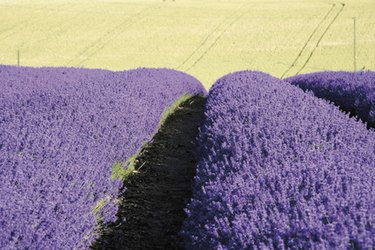
Also called a "humid continental climate," a continental climate is a major climate classification that is marked by hot summers and cold winters, found in central and eastern North America and parts of Asia and Europe. There are countless varieties of humid continental plants (or continental climate plants), and they can thrive with little or lots of precipitation, periods of snow, high winds and other weather surprises.
Humid Continental Plants
Video of the Day
Continental climates usually have winter temperatures that range from 10 to 45 degrees Fahrenheit in the daytime and 10 to 25 degrees during the night. In the summer, temperatures are normally from 65 to 90 degrees, with yearly precipitation being anywhere from 24 to 48 inches (rain or snow). Plants that grow there adapt to these extremes and evolve as well. In the North, there are evergreens, and there are broad-leaved (deciduous) trees as one heads South. Most kinds of shrubs and grasses can survive in these regions as well.
Video of the Day
It is difficult to say specifically which plants grow in a continental region, as there are truly countless species that thrive there. Some examples include American cranberrybush (Viburnum trilobum, USDA plant hardiness zones 2 to 7), a white flowering shrub; the coneflower (Echinacea purpurea, zones 5 through 8), which attracts butterflies; and white sage (Salvia apiana, zones 8 through 11), which has many traditional uses for Native Americans. Others include wintergreen (Gaultheria procumbens, zones 3 through 7), with green shiny leaves and white flowers that turn into red berries in the cooler months, and many bulb plants, like any species of iris (Iris germanica, zones 3 through 10). These feature lovely, upright petals and drooping sepals that are often vivid yellow, purple or blue.
Gaillardia (Gaillardia aristata, zones 4 to 8) is a stunning and easily cultivated perennial with red, orange and yellow petals. It can take over a garden bed in no time, making it a favorite among gardeners. Greenery like the maidenhair fern (Adiantum pedatum, zones 8 to 10) are often found in wooded areas and on roadsides. Hydrangeas of all varieties tend to thrive in the continental climate. The oakleaf hydrangea (Hydrangea quercifolia, zones 3 to 8) is a popular choice for its large blooms.
More Familiar Continental Plants
There are several even more familiar continental climate plants: everlasting pea (Lathyrus latifolius, zones 5 to 9), bigleaf maple (Acer macrophyllum, zones 5 to 9) and English holly (Ilex aquifolium, zones 5 to 9). The everlasting pea is a perennial flower that produces oval-shaped green leaves and white or purplish-pink flowers in spring through fall.
The bigleaf maple is a familiar deciduous tree that can soar up to 100 feet high with a dark brown, ridged bark and five-fingered leaves that can be 6 to 12 inches wide. These maples also sport small yellow blossoms and those double-winged, tan seeds that fly off in different directions. English holly is an evergreen tree and can grow up to 50 feet tall. Its notable characteristics include dark green, wavy-edged spiny leaves and yellow, orange and red berries.
Humid Continental Animals
Since this climate supports such a wide variety of plant life, it naturally follows that there is a correspondingly large amount of different animals living there. Larger hooved and clawed mammals that can adapt to harsh winters and strong storms, like horses, deer, bears and antelope, are common. Their thick fur protects them from the elements, and most are herbivores that enjoy the tasty grasses on the prairies and deciduous trees, like the bigleaf maple.
Smaller mammals, like squirrels, rabbits, raccoons and skunks, are also prevalent, and they eat grass plus large animal carcasses and insects. Many of these animals have to hibernate in the winter to survive. You won't find many larger predators, like tigers, in this climate except for bears since there is less cover for them to hunt effectively. Smaller predators, like foxes and wolves, hunt in packs or use other strategies and don't have to worry so much about being hidden.
Other humid continental climate inhabitants include lizards, frogs, snakes, waterfowl and birds. You won't see them during certain times of the year; one obvious reason is that birds and waterfowl migrate to warmer locales when it gets too cold. Fish like this climate too. Some of the most common native species include salmon, sturgeon, bass, perch, flounder and eel.
- Bob Vila: 34 Amazing Plants That Are Native to North America
- Britannica: Continental Climate
- WorldAtlas: What Is A Continental Climate?
- White Flower Farm: North American Native Plants
- Britannica: Asia - Plant Life
- Reference.com: What Animals Live in a Humid Continental Climate?
- Climate Types for Kids: Humid Continental Climate
- USDA Plant Hardiness Zone Map